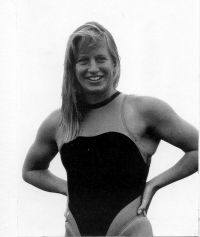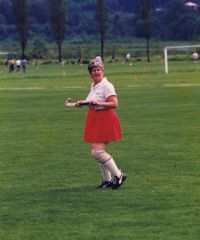In The Beginning
Lester and Frank Patrick both loved hockey and in the years after the turn of the century they became great stars. Lester played a season with Brandon in 1904, where he set a precedent for defensemen by rushing the opposing goal. From 1906 to 1908 he played with the Montreal Wanderers when they won the Stanley Cup three times. During that time Frank played with McGill University and the Montreal Victorias and he and Lester were often opponents. It was not until the Patrick's moved to Nelson that they played together and in 1909 signed contracts with the fabulous Renfrew Millionaires.

Frank Patrick
Victoria Pioneered Artificial Ice Rinks In Canada
In the spring of 1911 the Patrick's father, Joseph, and his two sons were sitting in their comfortable home in Nelson, B.C. discussing the family fortune, made from the sale of their lumber company and wondering what to do with it. They decided to move to the Pacific coast and pursue a venture of bringing ice skating and professional hockey to the cities of Victoria and Vancouver.
Enjoying The Boom
At that time the population of Victoria was about 25,000. Oak Bay had been incorporated; Esquimalt was growing as a naval base and Saanich was beginning to sprout. There was a land boom and there were predictions that the population would be 125,000 by 1914! New buildings, including two "skyscrapers," were constructed in town. Large subdivisions in Fairfield, Fernwood and the Quadra area were opening up. Money had been approved for paved streets, boulevards, cluster lights and sewers. Lots on Dallas Road sold for $3,500 while a corner lot at Yates and Vancouver sold for $45,000. Properties were purchased on Saturday night and sold on Monday morning for handsome profits.
First In Canada
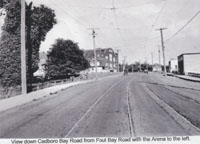
Patrick Arena
The Patricks set about planning two artificial ice rinks and decided to construct the Vancouver one of wood with a brick veneer that would seat 10,000 and be managed by Frank. The Victoria arena, under Lester's control, would be built entirely of wood with seating for 3,500. A site was picked a way out in Oak Bay, near the Willows Exhibition Grounds. The reason being cheaper taxes and that the location was serviced by the Willows streetcar. The original Victoria Arena, located at Cadboro Bay Rd. and Epworth St. was built at a cost of $110,000. There was great excitement in Victoria at the official opening on Christmas Day, 1911. It was a glorious afternoon and 600 skaters were skating to a real live band on the first artificial ice rink in Canada.
Money Talked
Top-level hockey in Canada was under the control of the National Hockey Association. With two clubs in Toronto and two in Montreal the players were signed for one season at a time. However hockey was in an interesting phase of its evolution as the game tried to gain a solid footing. In the preceding seasons different cities and, in some cases, small towns gathered hockey players together to challenge for the Canadian amateur championship. Clubs, anxious to produce winning teams, would find some way to hold their best players as well as entice "strangers" to dwell in their midst for a season. Semi -professionalism was rampant and in many cases players were receiving payment for their services. Although Lester and Frank had made between $2000 and $3000 playing for the Millionaires, $700 a season was the average pay.
Picked The Best

Senators 1912
It was in this atmosphere that the Patrick's considered the manpower for their first three pro teams. Their solution was simple. Pick out the players they wanted and offer them double the salary they had received the year before. Then word that the first professional hockey game to be played on artificial ice, anywhere in the world, had been set for Victoria on January 2, 1912. Victoria's opponents would be the homeless New Westminster team who shared the mainland arena with the Vancouver Millionaires.
Turned The Tables
Three nights later pro hockey made it's debut on the mainland. The magnificent Vancouver Arena opened with the white and maroon uniformed Vancouver Millionaires facing New Westminster. The Millionaires defeated the Royals by an identical score as in the opener at Victoria. An entire hockey season, including all the league and playoff games and professional hockey's first East vs West series in history, was crowded into three months. The teams neared the end of the season closely bunched with Vancouver holding a narrow lead. Then Victoria beat them and four days later, Harry Hyland, one of the great forwards of the day, scored four goals when New Westminster Royals defeated Vancouver to become the first Pacific Coast Hockey Association champions.
Sought World Series
Once the Patricks had their league going they envisioned a world series in hockey. They challenged the National Hockey Association to send its champion to the Pacific Coast to meet the winners of their league. Still smarting from the P.C.H.A. raiding players the N.H.A., who by this time were playing six-man hockey, would have nothing to do with the idea. However, the Patricks had a solid friend in Art Ross and when Ross was informed of the league's action he fell in and brought a team of All-Stars from the East to play against the Pacific Coast All-Stars. Ross came west with goalkeeper Paddy Moran, Cyclone Taylor, Skene Ronan, Joe Malone, Odie Cleghorn, Jack McDonald and spares Sprague Cleghorn, Hamby Shore and Jack Darragh. The Coast All-Stars had Lehman in goal, with Frank Patrick at point and Ernie "Moose" Johnson cover, Newsy Lalonde rover, with Tommy Dunderdale at centre and Harry Hyland and Rand McDonald on the wings. Lester Patrick and Jimmy Gardiner were the spares. The coast team was too powerful for Ross' All-Stars and won the first game, 10-4, in Vancouver with Dunderdale punching home four goals. The second game, at Victoria, saw the Coast All-Stars win, 8-2. Dunderdale scoring twice and Hyland tallied four times. The final game, back in Vancouver, was played under the eastern six-man rules and was won 6-5 by the visitors. The series had been a success as the players earned extra money and the fans saw new faces - but the games had been purely exhibitions.
Victoria Wins Championship & Enters First World Series of Hockey
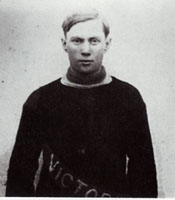
Tommy Dunderdale
Before the next season began, the Patricks negotiated for a series between the champions of the two leagues. The Stanley Cup would be at stake and was to be emblematic of the hockey championship of the world. When the 1912-13 season opened the teams knew of the rewards waiting the regular season winners. Victoria, renamed the Aristocrats, were strengthened by the arrival of Goldie Prodgers, Bob Genge and "Dummy" Ulrich. In a surprising show of strength they jumped out in front and with one game to be played, they sewed up the league having a record of 10 wins and 5 losses. In addition to winning the title Victoria also had the league's leading goal scorer as team captain, Tommy Dunderdale, fired in 24 goals in 15 games. Victoria Arena was sold out for the world series of hockey and Quebec, with several top-ranking players of the times, was confident of winning. Victoria, who had plenty of speed, several deadly shooters and a tough defense won the first game by a 7-5 count. The second game was played under eastern rules and Victoria fans saw six-man hockey for the first time. Quebec gave the Aristocrats a going-over, winning 6-3. In the final and deciding game of the series Victoria swamped Quebec, 6-1, with Dunderdale and Lester Patrick each scoring two goals.
Stanley Cup Withheld

Aristrocrats 1913
The Victoria Aristocrats had become the first national champions in professional hockey. However, they did not gain possession of the Stanley Cup as the N.H.A. had refused to sanction its use as hockey's world series trophy. When professional hockey was ushered into the capital city the amateurs also came bobbing up for recognition. In the second year of the arena they had a three-team league of B.C. Telephone, the Y.M.C.A. and the champion Victoria City. The 1913-14 season opened with the N.H.A. agreeing that the Stanley Cup would be up for competition between the western and eastern winners. Although Victoria had just won the coast title another crafty forward, Dubby Kerr, was added to their line-up. Victoria again proved too fast for Vancouver and Portland, who had taken over the New Westminster franchise. A second P.C.H.A. championship came to the capital city and it was their turn to trek east in quest of hockey's world series and the Stanley Cup. Their opponents would be the Toronto Arenas.
Quickly Over
A best-of-five series was over in three games. The opening game, played under eastern rules, was won by Toronto. The second game was played under seven-man rules, but Victoria lost in overtime. By the time the third game came up Victoria had learned a few things about the six-man game but lost again a by 2-1 count to end the series. Just as hockey was rolling along famously the Great War broke out and the Canadian government took over the Willows Exhibition buildings and also the Victoria Arena for military purposes. The authorities didn't commandeer Vancouver's arena so they and Portland continued to operate while the Victoria franchise moved to Spokane.
Rules Changed and Hockey Revolutionized
After the 1918 Armistice and the release of the Arena by the military, the amateurs really began to shine. A four-team league consisting of the Foundation Club, Senators, Two Jacks and the Elks was formed. The player rosters of that day included active members of our community. Besides player-manager George Straith, the Senators had Ernie Cook, a Victoria High School teacher who later coached the Canadian Champion Blue Ribbons basketball team. Also Harry Smith, the principal of Victoria High and Louie Glazan manager of Victoria Box & Paper. Other Senator players were: Irwin, Newett, Barney Quinn, Al Miller and goalkeeper Percy Watson. Playing with Jack O'Brien's Two Jacks were "Rip" McDonald, Ed Savannah, on staff at Victoria College, Ross Miller, Mc Allister, Gandy, and Vic West soccer players Mulcahy, Shandley and Copas. Vic Gravelin, later sports editor of the Colonist, was in goal. Foundation had Charlie Burnett between the pipes and his brother, Hughie, on defence along with Eric George, Perry, T. Hann, Dudley, Elmer and Jerry Tobin. Elks iced goalie Herb Reilly with Darrell Spence, H. Belierose Percy Fitzsimmons, Vic King, Len Warnicker, McKerile, Woods and Mair.
Drew Good Crowds
Amateur hockey proved popular and drew good crowds of up to 2000 spectatorsa game. The 1918-19 playoffs saw Foundations defeat the Senators in the finals to capture the Dudleigh Cup. The shipyards had closed down and some of their players, including Hughie Burnett and Alex Straith, went to the Senators. Along with John Wickson, Percy Fitzsimmons, Ed Dieldal, Leo Dowd and Art Moore they won the Victoria title in 1919/20 and for several seasons were invincible in local amateur circles. Lester Patrick's team returned here to resume operations and he set about rebuilding his Aristocrats. That proved to be a slow process and it was not until 1923 that things began to look up. During those intervening years there was a night that was long remembered by the Victoria fans. It was "Moose" Johnson Night on March 4, 1921.
A Place In History
Victoria was hosting Seattle and the evening started out like any other "named" night with the presentations to the popular defence-man, "Moose" Johnson. Before the game was two minutes old Jim Riley scored for Seattle and another by Frank Foyston put the Mets up two goals at the first interval. Early in the second period Clem Loughlin got one back for the home side before Riley scored again to restore the Mets two-goal lead. Victoria came back strong after Oatman connected and went ahead on goals by Harry Meeking and Wilf Loughlin. They fought to protect that lead but Foyston evened up the count and forced the game into overtime. The first 20 minutes of extra time passed with Victoria showing brilliant form and only Holmes' uncanny work in the Seattle goal prevented them from scoring. Another 20 minutes of extra time began with the fans sensing the dramatic. But there was no scoring and towards the end the players began to show signs of exhaustion. In the third overtime some players were having difficulty staying on their feet and play slowed to a crawl. Midnight arrived with the teams still deadlocked. After the gong sounded to end the sixth period of play, both teams agreed it would be inhuman to send the players back on the ice. The fans had had enough after two full games for the price of one. They would never forget "Moose Johnson Night" and the game-length record of 120 minutes that once again put Victoria in the hockey history book.
Victoria Reaches The Pinnacle, Cougars Win Stanley Cup
In 1923,with one year remaining on the Seattle arena lease, the owners offered $10,000 to vacate the place early. The Patricks were aware of an awakening interest of hockey in the eastern United States. It was only a question of time before the big cities like New York, Boston, Detroit and Chicago would want professional hockey and were able to pay player salaries far greater than the Pacific Coast League could afford. A decision was made to take the money and vacate the Seattle Arena. That resulted in Victoria and Vancouver joining with Calgary, Edmonton, Regina and Saskatoon in the Western Canada Hockey League. The Seattle Metropolitans players were distributed and since Victoria had not had much to cheer about following the war, the league directors decided that Lester should have a break. To the surprise of Victoria fans it was announced that Frank Foyston, Jack Walker, "Hap" Holmes and Gordon Fraser had been awarded to the newly named Victoria Cougars. They provided Victoria with a top-ranking goalie, a sterling defence-man and two of the smartest forwards in hockey. When the 1924-25 season rolled around, Lester, who had retired as a player in 1921, devoted himself to coaching the Cougars, running his arena and teaching his sons, Muzz and Lynn, the skills of hockey.
Whirlwind Start
Victoria got off to a whirlwind start and not only won the first game from Calgary, they also defeated the defending champions, Vancouver, in the second game. It certainly looked as if Victoria would be the team to beat. However, on a swing through the prairies the Cougars played three games and lost them all. When the regular schedule ended Victoria was not on top as expected. Calgary lead with 34 points, Saskatoon was second with 33 and Victoria third with 32 points. But the Cougars were in top form for the playoffs and met Saskatoon in the first round. A two-game total-goals series finished with Victoria winning, 6 goals to 4 and meant that they opposed the Calgary Tigers in the final round for the W.C.H.L. title. The first game was played in Calgary where the Cougars eked out a 1-1 draw. Excitement was at a fever pitch in Victoria and the demand for the deciding game tickets could not be satisfied. There were 4,200 fans jammed in the Arena when the teams skated out for the opening face-off. Calgary were not able to tie up Frederickson's goals and "Hap" Holmes was invincible in shutting out the Tigers 2-0. Victoria had claimed the series and a crack at the world championship Stanley Cup.
Colorful Canadiens
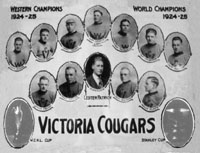
Cougars 1924
Victoria fans were in hockey heaven for 10 days. They knew they would be seeing some colorful eastern hockey players like Howie Morenz, Auriel Joliat and Georges Vezina in action. There was ticket frenzy as fans lined up the night before and by morning a line extended down to Government Street, along to Fort and up Broad Street. The Victoria Arena was sold out and in order to make the players' share larger, one game was scheduled in Vancouver. In the championship series the rules always favored the home team and by the 1924/25 season the W.C.H.L. were playing six-man hockey and allowing forward passes in the attacking zone. The first game had to be played under Western rules and it proved to be an exhibition of speed, stick handling, passing and shooting by the Cougars as they won 5-2.
The Cup At Last
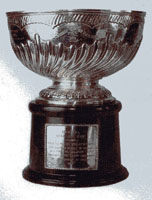
Stanley Cup1924
The second game, played in Vancouver under eastern rules, saw the Canadiens play better but not good enough, losing 3-1. Morenz was really flying in the third game and scored three goals on breakaways for a 4-2 Montreal victory. In the fourth match-up the Cougars were really clicking and took the series with an amazing display and a final score of 6-1. After referee Mickey Ion blew the final whistle there was delirium in the arena. At last the Stanley Cup had come to Victoria. Today, many people are surprised to see Victoria's name on the cup and it is hard for newcomers to believe that we once had a world championship hockey team.
Defending Champions
When the next season dawned Victoria fans confidently thought they would sit back and watch the Cougars sweep through to another championship. The Cougars trained in Winnipeg and made a pre-season exhibition tour of the east. There they opened the eyes of the fans as to the calibre of western hockey. In the end Victoria did win but the struggle was one of the epics of the sport. The 1925-26 Cougars had the same line-up, except that Frank Foyston had decided to retire. The Regina franchise went to Portland and that resulted in the league name changing from Western Canada to the Western Hockey League. By mid-December Victoria had played five games and hadn't won a single one. On top of that "Slim" Halderson had sustained a severe foot cut and Gordon Fraser a broken leg. When "Jocko" Anderson suffered a broken nose the Cougars were reeling. Then Lester made a remarkable decision to return to the game. Now 42 and in his first game on the comeback trail the Cougars defeated Portland, 2-1, for their first win. There was great joy in Victoria when it was announced that Frank Foyston would return to the Cougars but it was the play of the remarkable "Old Silver Fox" who really pulled the Cougars' together. When the schedule finished Edmonton was on top with 38 points, Saskatoon second with 37 and Victoria third with 34.
The End of Victoria's Hockey Rainbow
Once again the playoffs were helpful to Victoria. They earned a 3-3 tie with Saskatoon in the first game of the semis but it proved costly. Lester Patrick received a slash that resulted in ending the playing season for him. In the second game of the home-and-away neither side were able to score during the regulation time. The series remained deadlocked until Gord Fraser stole the puck and went straight down center ice, split the defenders and fired a bullet shot that ended the game after 8 minutes of overtime. Victoria gained the right to meet Edmonton for the championship and the Cougars, who had their sights set on defending their world championship, were not to be denied. They defeated Edmonton, 3-1, on Victoria ice and played to a 3-3 tie before 10,000 fans in the second game at Vancouver.The Cougars were happy that the Montreal Maroons would be their opposition. The English-speaking Montreal hockey crowd, wanting a team of their own, went after a N.H.L. franchise in 1925. They got it and promptly put together a cracking good club. In their second season the Maroons won the N.H.L. championship and would host the first Stanley Cup championships to be held in the new Forum. As well as playing in Canada's most up-to-date arena, seating more than 10,000 fans, it would mean a larger amount in the player's split. The first game was only a few minutes old when "Jocko" Anderson, the pint-sized Victoria forward, broke his leg. The final count was 3-0 in favor of Montreal and Victoria also lost the second match-up by the same count. There was talk of sweeping the series in three straight games; however, a lucky early goal got the Cougars in stride and they fired in two more for a 3-2 victory in game three. The fourth match-up was a hectic affair that the Maroons won, 2-0.
West Was Doomed
As the Cougars headed home, little did they know they had played their final game in a Victoria uniform and on the Pacific Coast. It was apparent that the Western Hockey League could not stay in contention with the eastern interests. The cities of Chicago and Detroit wanted pro hockey and New York was looking for a second club. For $300,000 it was agreed to turn over the players of the six western clubs. That deal sent the Cougars to Detroit and for their initial N.H.L. season they were called the Detroit Cougars before being renamed the Falcons and finally, the Red Wings.
Well Known Victorians Play On Amateur Clubs
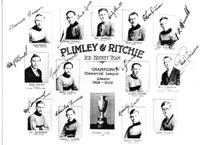
Plimley Ritchie 1928
With the sale of the professional Cougars the amateurs had hockey to themselves. Players in the amateur league changed with the years and in 1926 the teams, and their line-ups were; Shell: Harry Stuart, Hugh Burnett, Roy Copas, Ross Miller, Jack Saunders, Albert Mummery, Jimmy Foster and Alan Tuckwell. Colonist: Hank Campbell, Hec Goodacre, Don Smith, Ivan Temple, Ross Oatman, Wilson and Jimmy Stewart. Navy: Alex Straith, Tommy Lumsden, Lay, "Rebel" Mowat," Fitzsimmons, Fest, Morris Green, Peckham and Mc Donald. Tillicums: Percy Watson, Simpson, Claude Belcher, Glazan, Ross Oatman, George "Jitney" Ford, Nelson, Rhodes and Nicholson. The seniors played to good crowds with Shells winning the Victoria title but loosing out to Vancouver Towers in the B.C. playoff. A Commercial League with teams known as the Rink Rats, Plimley & Ritchie, Travelers and International Engineering School also had a good following. As well, two girl's teams, the Cougarettes and the Cardinals, invaded the ice hockey circle and arranged games with outside teams. In 1928 Victoria entered a team, coached by "Jocko" Anderson, into an inter-city amateur league. They had the pick of the local amateurs and won the series to bring the B.C. championship, Wilkinson Cup, to Victoria. Then came the fire that destroyed the great historical wooden building on November 11th, 1929. The throng standing around the blazing building recalled the many exciting times they had had in it and felt they were really watching the finish of hockey in Victoria.
Arena Fund Bid Fails
After the loss of the Patrick Arena, sports figures constantly agitated for a new rink. It was not until 1937 that the Victoria Gyro Club suggested that an investigation be made to see if the old Woolen Mill, near Ogden Point, could be converted into an ice skating rink. They also considered a site on Douglas Street near the Hudson's Bay store where they planned to get refrigeration from the nearby Wilson ice plant and expected that a suitable building could be constructed for $150,000. Years passed, Hitler started on his rampage and we were into another world war. In January 1940, the Junior Chamber of Commerce held a discussion on the building of a new arena. After both efforts failed, people were convinced that funds for a new arena could not be raised by public subscription. So the idea that perhaps the old Willows Horse Show Building could be converted into one. It was felt it would be better to have skating there than to have no ice-skating or hockey at all. In 1941, the City Council, who controlled the Willows property, approved $6,500 to be used to improve the Horse Show Building, if any citizen or group would put in an ice-making system and operate the arena.
Olson Steps In
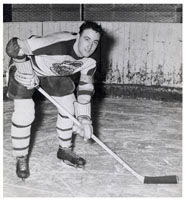
Bernie Strongman 1943
Only one man, "Barney" Olson was willing to take a chance and he went ahead to get the necessary equipment installed. There was great joy when, after a wait of a dozen years, Victoria had a second arena. People besieged the sporting-good shops for skates and hundreds of eastern men, stationed here with the forces, sent home for their hockey equipment. Once again Victoria became prominent in amateur hockey as a Pacific Coast Amateur League was formed with teams from Victoria, Nanaimo, Vancouver and New Westminster. The 1941-42 Victoria team, sponsored by Pendrey Paint Company, played under the name Bapco's. By the time the 1942/43 season rolled around a number of former National Hockey League and minor pro league players were stationed here in the armed services and ship building plants. An Island League was formed with entries from the Army, Navy, Air Force, Nanaimo and the Victoria Machinery Depot. "Chuck" Rayner, a long-term star goalkeeper with the New York Rangers played in the net for the Navy. Bob Godhamp of the Chicago Black Hawks, was also a blue jacket, as well as Bernie Strongman, who returned after the war to captain the Victoria Cougars in the early 1950's. In the closing days of the league race none of the clubs could hold back the solders. Army had Bill Carse, later the Vancouver Canucks playing coach, and Nick Metz from the Toronto Maple Leafs. The solders went on to win the B.C. championship playoff and the Savage Cup. With one-sided scores of 10-1, 18-5 and a 10-5 count against Vancouver - R.C.A.F. they finished the series with an 11-2 victory after being set back in the fourth encounter.
Victoria's Army team moved on to Calgary for a series with the Alberta champions. After falling behind two games to one, the Victoria squad took the last two by 4-3 and 4-2 scores to earn the right to play Winnipeg R.C.A.F for the Western Canadian championship. The soldiers were again victorious and after splitting the first two games had enough power to take the series with 4-3 and 7-4 counts. That meant the local Army team would play for the Canadian Amateur Championship's Allan Cup in Winnipeg. There they faced the N.H.L. star-studded Ottawa Commandoes in the finals. After loosing the first two games they won the third and in the tight fourth match-up the Commandos won, 2-0, and finished Victoria's chance to capture the Allan Cup. Before another season rolled around most of the players on the service teams were being ordered overseas. With their going, amateur hockey slumped but through the efforts of Ivan Temple and Doug Fletcher, Victoria boys got a start in minor hockey. Also the Victoria Figure Skating Club, which had organized in the Patrick arena, was re-established with their Ice Capades show being a big hit.
Another Cruel Blow
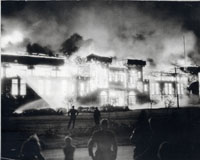
Willows Arena Fire
Then came another cruel blow, when for the second time, fire struck. The old shingle-covered, wooden building and the similar adjoining Sports Centre, went up in a spectacular nighttime fire. Within a few hours there was nothing but twisted pipes, smoldering embers and another sad night for Victoria's sporting community. This time, however, the citizens didn't let the fire keep them down. They were determined that they would have a new arena that wouldn't burn down. Why not build a Municipal Arena as a memorial to the men who had given their lives in the Second World War? There were reports that a Citizens' Committee could raise $65,000 by public canvassing. Donations came in from large companies to kids collecting door to door. At a city council meeting the offer was accepted and the City agreed to place a by-law before the ratepayers asking for $150,000. It passed and it was expected that a modest arena could be constructed for the $215,000. But it was not to be. No one wanted to loose a third arena by fire. So it was decided that the Memorial Arena, should be a concrete, barrel-roof construction and completely fireproof. Building costs soared with two additional loans having to be approved. When the Memorial Arena finally opened the cost of $995,979.03 - might as well call it a cool million - was made public.
Dream Comes True
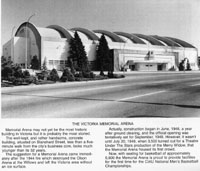
Memorial Arena
When the arena began operation in 1949, thousands of young people were skating, hundreds of boys began to play minor ice hockey and the figure skaters had their third home. The Western Hockey League had restarted after the war and now another professional hockey franchise would go to Lester Patrick's Victoria Cougars. The Capital City, twice the size it was when pro hockey was first played here, was again in the throes of hockey fever. But they soon found the new rink wasn't big enough to handle the crowds at Cougar hockey and Shamrock lacrosse games.


